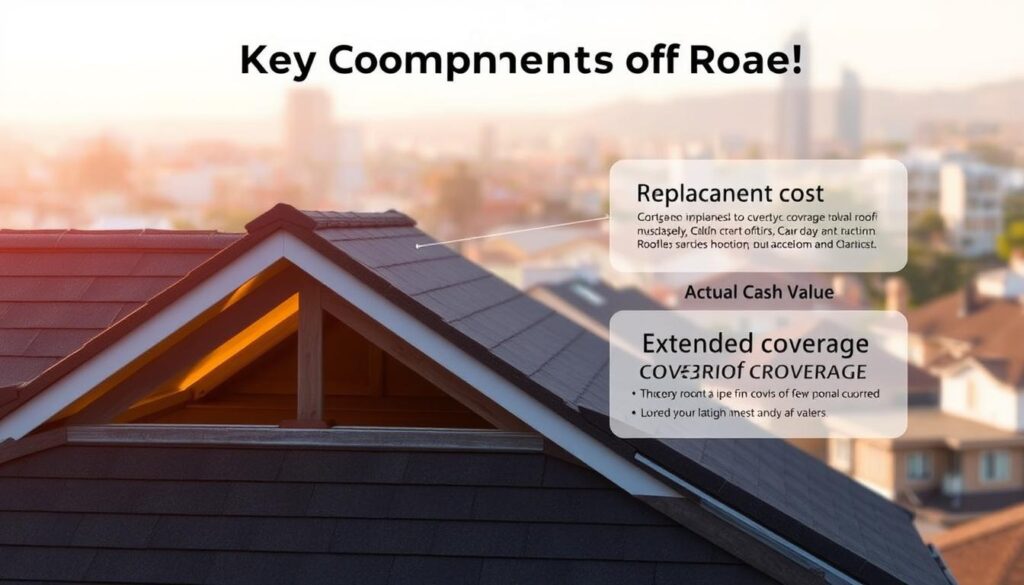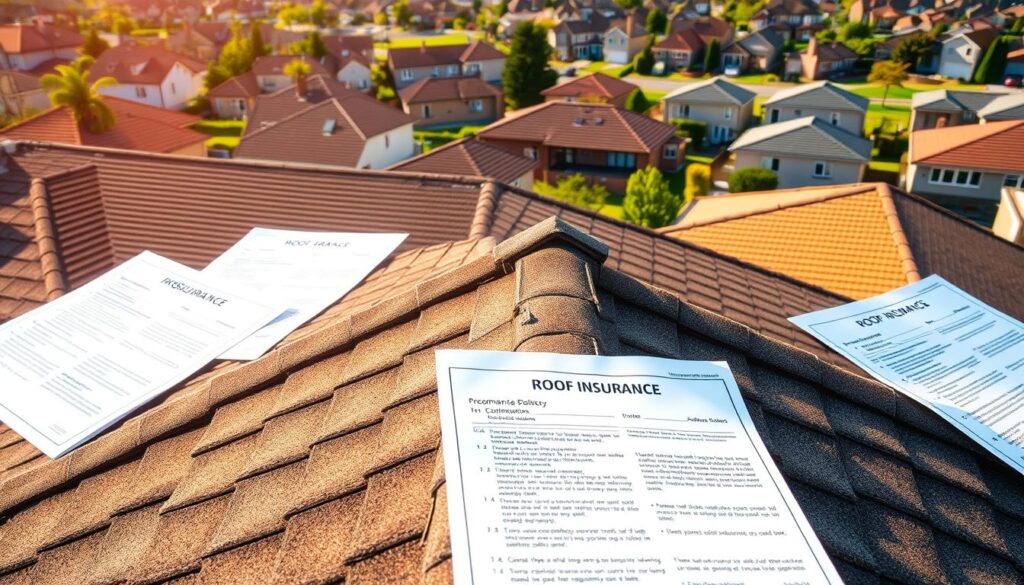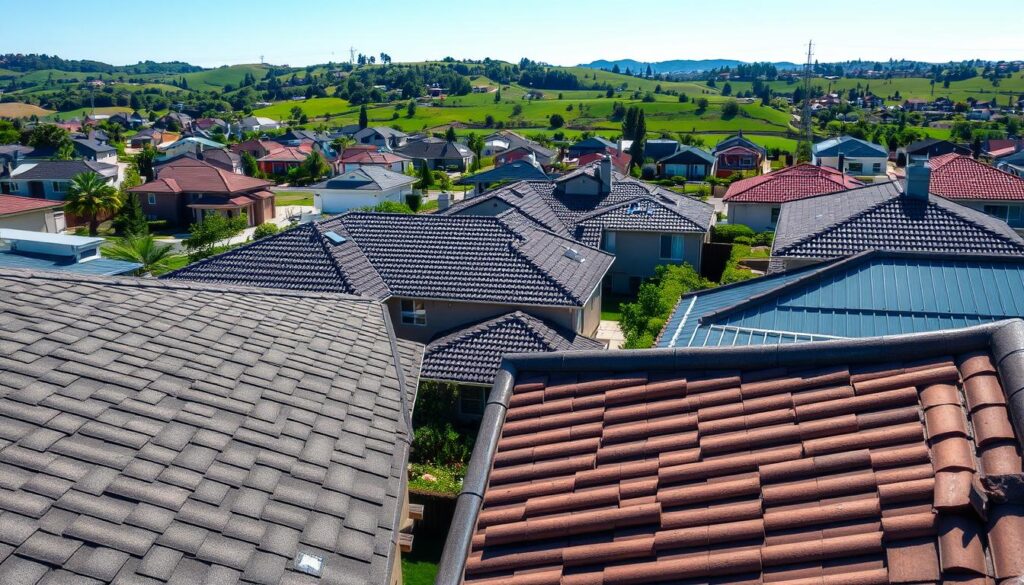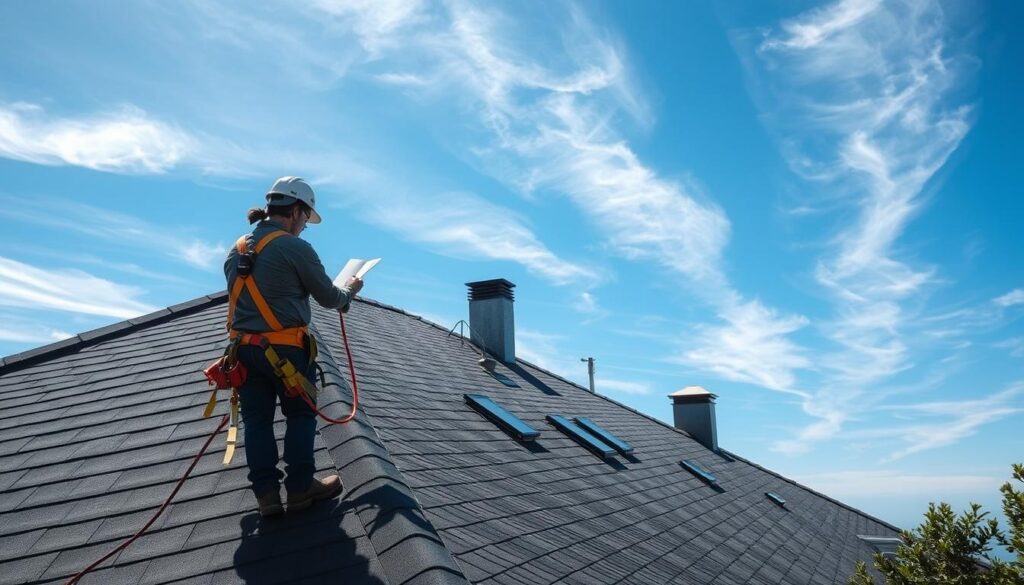Homeowners in California often face complex insurance terms. One key term is RFR in roof insurance coverage.
RFR, or the replacement cost of a roof, is a big deal in figuring out insurance payouts for roof damage.
In California’s varied climate and geological risks, knowing about RFR is essential. It helps homeowners make sure they have enough coverage.
This is especially true because California is prone to natural disasters. These disasters can really hurt roof integrity and overall property value.
Key Takeaways
- Understanding RFR is crucial for California homeowners.
- RFR impacts insurance payouts for roof damages.
- Adequate coverage is vital due to California’s climate and geological risks.
- Homeowners should review their insurance policies to ensure they cover the full replacement cost.
- Regular roof maintenance can help prevent damages and disputes over insurance claims.
Understanding RFR in Roof Insurance
Grasping RFR is key when dealing with Roof Insurance in California. RFR is a critical factor in roof insurance claims. It plays a big role in how insurance policies work.
Defining RFR
RFR stands for a crucial factor in roof damage claims. It’s vital to know that RFR affects coverage and the claim process. RFR shows the roof’s remaining life, deciding if it can be fixed or needs a new one.
The definition of RFR is linked to the roof’s condition and age. Insurance companies use RFR to predict future damage and repair costs. This is important for figuring out premium costs and coverage terms in roof insurance policies.
Importance of RFR in Coverage
RFR’s role in roof insurance is huge. It affects the claim process and insurance costs. Knowing about RFR helps homeowners in California make smart choices about their roof insurance.
A roof with low RFR is close to needing a new one, which might raise insurance costs. On the other hand, a roof with high RFR is in better shape, leading to better insurance deals.
Remember, RFR isn’t fixed; it can change with roof maintenance. Keeping your roof in good shape can improve its RFR. This could lead to better insurance terms for you.
Key Components of Roof Insurance
Roof insurance is complex and has many parts. Knowing these parts is key for homeowners to choose the right coverage.
Coverage Types Explained
Roof insurance policies have different coverages. These include actual cash value (ACV), replacement cost value (RCV), and extended replacement cost value. ACV pays for the roof’s current value minus depreciation. RCV covers the full cost to replace the roof without depreciation. Extended replacement cost value adds extra coverage for unexpected repair costs.
The coverage you choose affects your premium and claim payouts. For example, RCV policies cost more but pay out more in claims. Think about your budget and roof’s condition when picking a coverage type.

Common Exclusions in Policies
Roof insurance covers many damages but has exclusions. These include damage from maintenance neglect, wear and tear, and some natural disasters. Knowing these exclusions helps avoid surprises when filing a claim.
| Exclusion Type | Description | Example |
|---|---|---|
| Maintenance Neglect | Damage from not keeping up with roof maintenance. | Not cleaning debris, causing water damage. |
| Wear and Tear | Roof damage from normal aging. | Shingles cracking or curling over time. |
| Natural Disasters | Events like earthquakes or floods not covered by standard policies. | Earthquake damage not in the policy. |
While “tow truck insurance quote” and “tow truck insurance coverage” aren’t directly related, learning about insurance helps with all types. This knowledge aids in making better choices for your insurance needs.
The Role of RFR in Policy Pricing
Knowing about RFR helps homeowners understand their insurance costs better. RFR, or Roof Failure Rating, is a key factor for insurance companies. It shows the risk of a roof failing.
The RFR affects how much homeowners pay for roof insurance. A higher RFR means a roof is more likely to fail. This leads to higher insurance costs. On the other hand, a lower RFR means a roof is more durable, which can lower insurance premiums.
How RFR Affects Premium Costs
The link between RFR and insurance costs is clear: higher RFR means higher premiums. Insurance companies see roofs with higher RFRs as riskier. This means they are more likely to need claims.
Factors that influence the cost include:
- The age and condition of the roof
- The materials used in the roof’s construction
- Environmental factors such as weather patterns and natural disaster risks
Factors Influencing RFR
Several things affect a roof’s RFR. These include its age, maintenance history, and materials. Regular checks and upkeep can improve a roof’s RFR. This helps spot and fix problems early.
For example, roofs made from materials like metal or slate tend to have lower RFRs. Roofs that are well-maintained also have better RFRs than those that are not.
| Factor | Impact on RFR | Effect on Premium Costs |
|---|---|---|
| Roof Age | Older roofs typically have a higher RFR | Increased premium costs |
| Roof Material | Durable materials lower RFR | Potential decrease in premium costs |
| Maintenance History | Regular maintenance improves RFR | Potential decrease in premium costs |
Types of Roof Insurance Available
It’s important for homeowners in California to know about the different roof insurance types. This helps them make smart choices.
Homeowners Insurance Overview
Homeowners insurance covers more than just the roof. It protects the whole house and its stuff from various dangers.
This insurance usually covers damage from storms, fires, and vandalism. But, how much it covers can change a lot. It depends on the policy and who you get it from.

Specialized Roof Insurance Options
Homeowners can also get specialized roof insurance. These policies focus on roof damage. They offer more detailed protection against certain risks.
| Insurance Type | Coverage | Premium Cost |
|---|---|---|
| Standard Homeowners | General coverage including roof | Variable |
| Specialized Roof Insurance | Specific coverage for roof damage | Generally higher |
Standard homeowners insurance gives broad coverage. But, specialized roof insurance is better for older roofs or areas with specific weather risks.
Getting roof insurance is like insuring a car. Homeowners should think about the cost and what’s covered. Knowing the monthly cost of affordable tow truck insurance can help compare roof insurance prices.
The Claims Process for Roof Damage
Filing a claim for roof damage has several key steps. Homeowners must follow these steps carefully for a smooth experience.
Filing a Claim: Essential Steps
To start, homeowners should document the damage well. They need to take clear, dated photos of the damage and list what’s affected.
Then, they should contact their insurance provider to report the damage. It’s important to do this quickly, as policies have time limits for claims.
After contacting the insurer, a claims adjuster will assess the damage. Being present during this assessment is helpful to ensure all damage is noted.
Required Documentation for Roof Damage Claims
Homeowners need to provide several documents for their claim. These include proof of ownership, maintenance records, and detailed descriptions of the damage.
The insurance company might also ask for estimates from contractors for repairs. Homeowners should be ready to provide several quotes to help the process.
While the exact documents needed can vary, having everything ready can make the process easier.
Understanding the claims process is also useful for other insurance areas. For example, knowing about tow truck insurance cost and rates is helpful. Clarity and documentation are key in both.
RFR and Roof Material Considerations
The material used for roofing can significantly impact the terms and conditions of insurance coverage.
Impact of Material on Coverage
The type of roofing material used can affect insurance coverage in several ways. For instance, roofs made from durable materials like metal or slate may qualify for lower premiums. This is because they last longer and are less prone to damage.
In contrast, roofs made from less durable materials such as asphalt shingles may result in higher premiums. This is because they are more prone to damage and need more frequent replacement.

Common Roof Types and Their Insurance Needs
Different types of roofs have varying insurance needs based on their material, age, and condition. For example, a roof with a high RFR rating, indicating good condition and functionality, may be eligible for more favorable insurance terms.
| Roof Type | Typical Insurance Needs | Premium Impact |
|---|---|---|
| Asphalt Shingles | Regular inspections, potential for higher claims | Higher premiums |
| Metal Roofing | Less frequent inspections, lower risk | Lower premiums |
| Slate Roofing | Specialized maintenance, high durability | Variable premiums |
Understanding the insurance needs of different roof types can help homeowners make informed decisions about their roofing material and insurance coverage.
Understanding Deductibles in Roof Insurance
The deductible is a key part of roof insurance that homeowners need to get. It’s the amount you pay first before your insurance helps with the rest of the claim cost.
Let’s say you have a $1,000 deductible and a $10,000 claim. You’ll pay the first $1,000, and your insurance will cover the $9,000 left. Knowing this helps you plan and manage your finances when roof damage happens.
How Deductibles Work
Deductibles in roof insurance can change a lot. They depend on your policy and who you’re with. Some might be a flat amount, while others are a percentage of your coverage.
For example, a 2% deductible on a $300,000 roof means you pay $6,000 before your insurance kicks in. Some companies let you pick your deductible, balancing cost and risk. But remember, a higher deductible means lower premiums but more financial burden if you need to make a claim.
Choosing the Right Deductible
Choosing the right deductible is about finding a balance. You want lower premiums but also need to be able to pay the deductible if needed. Think about your finances, roof value, and how much risk you’re okay with.
Comparing different deductibles and their effects on premiums can help. Here’s a table showing how deductibles can change your annual premium:
| Deductible Amount | Annual Premium |
|---|---|
| $500 | $1,200 |
| $1,000 | $1,000 |
| $2,000 | $800 |
This example shows deductibles and premiums are inversely related. Use these comparisons to find a deductible that fits your budget and insurance needs.
Just like tow truck insurance coverage, roof insurance needs careful deductible selection. Understanding deductibles and choosing wisely ensures you get the best tow truck insurance rates or the right roof insurance for you.
The Importance of Regular Roof Inspections
Regular roof inspections can greatly extend your roof’s life. They help spot problems early, preventing small issues from becoming big ones. This way, your roof stays in top shape, lasting longer.
Benefits of Routine Checks
Regular roof checks have many advantages. They catch damage early, cut down on maintenance costs, and make your home safer. Inspectors look for signs like cracked shingles, damaged flashing, and clogged gutters.
Fixing these problems quickly saves you money on repairs later. It also keeps your insurance coverage in check. Insurance companies want roofs in good shape to cover claims. Not doing so might lead to denied claims or higher premiums.

Impact on Insurance Coverage
Regular roof inspections are key to keeping your insurance in order. A well-maintained roof avoids disputes with insurance companies over damage. This can lead to better policy terms, including lower premiums.
| Inspection Frequency | Average Cost Savings | Impact on Insurance Premiums |
|---|---|---|
| Annual | $500 | Reduced by 10% |
| Bi-Annual | $800 | Reduced by 15% |
| Every 5 Years | $200 | No significant impact |
In summary, regular roof inspections are crucial. They keep your roof healthy and ensure you have the right insurance. By doing routine checks, you save money, stay safe, and have peace of mind.
California-Specific Regulations
Knowing California’s rules is key to getting the most from roof insurance. Homeowners must follow state laws and local building codes. These rules can affect their roof insurance coverage a lot.
State Laws Affecting Roof Insurance
California’s laws are important for roof insurance. For example, laws about insurance disclosure and policy transparency are key. Insurance companies must clearly explain what their policies cover and what they don’t.
Also, California has rules for insurance claims processing. Insurance companies must handle claims quickly and fairly. This ensures homeowners get the money they deserve without waiting too long.
| State Law | Description | Impact on Roof Insurance |
|---|---|---|
| Insurance Disclosure Law | Requires insurance companies to clearly disclose policy terms | Enhances transparency, helping homeowners understand their coverage |
| Claims Processing Regulation | Mandates timely and fair processing of insurance claims | Ensures homeowners receive compensation in a timely manner |
Understanding Local Building Codes
Local building codes in California are very important for roof insurance. They set the standards for roof construction or repair. Following these codes is not just legal; it’s also essential for insurability.
In areas prone to disasters like wildfires or earthquakes, roofs must meet special requirements. If a roof doesn’t meet these standards, insurance claims might be rejected.
While focusing on roof insurance, it’s good to know about the bigger picture. For example, learning about how much is tow truck insurance per month or tow truck insurance cost can help with budgeting for other insurance needs.
Evaluating Roof Insurance Providers
Understanding roof insurance providers is key for homeowners. It helps them choose a policy that fits their needs.
Researching Insurers in California
In California, researching roof insurance providers is crucial. Look at their reputation, financial health, and customer service. Homeowners should pick insurers known for paying claims and great customer support.
Start by checking online reviews and asking friends for recommendations. Also, talk to insurance agents who focus on roof insurance. This will help narrow down your choices.
What to Look for in a Policy
After finding potential insurers, review their policies closely. Ensure the policy covers damage from weather and repairs or replacements. The average cost of tow truck insurance might not apply, but it helps understand insurance pricing.
Consider the deductible, coverage limits, and any exclusions. Also, ask about extra features or riders for better protection.

By carefully looking at roof insurance providers and their policies, homeowners in California can find the right coverage. This protects their investment.
The Role of Age in Roof Insurance
Knowing how roof age affects insurance is key for homeowners. The age of a roof is a big deal for insurance companies. They use it to decide how much coverage to offer and what the premiums will be.
Impact of Roof Age on Coverage
Roof age plays a big role in insurance coverage. Older roofs are more likely to get damaged. They might also not meet today’s building codes.
Because of this, insurance companies see older roofs as riskier. They might charge more for insurance or exclude certain damages. For example, they might not cover damage to very old roofs.
Options for Older Roofs
Homeowners with older roofs have a few choices. They can upgrade or replace their roof with newer materials. This meets today’s building standards.
They can also try to get better insurance terms. Some insurers might offer better deals if the roof is well-maintained or upgraded.
| Roof Age | Insurance Implications | Potential Actions |
|---|---|---|
| 0-10 years | Typically considered low risk; premiums may be lower. | Regular maintenance is recommended. |
| 11-20 years | May start to see increased premiums due to aging. | Consider inspections to identify potential issues. |
| 21+ years | Often viewed as high risk; may face higher premiums or exclusions. | Upgrading or replacing the roof may be necessary for better coverage. |
Roof age and insurance are different from other types, like tow truck insurance quote or tow truck insurance coverage. But understanding risk and coverage can help with many insurance types.
Common Misconceptions About Roof Insurance
Roof insurance can be tricky, with many myths around RFR and what’s covered. Homeowners often don’t know what their policies include. This can lead to surprises when they file claims.
Debunking Myths Surrounding RFR
Many think RFR means a roof is fully covered for any damage. But, RFR only covers the functional replacement cost of a roof. It doesn’t cover full replacement or cosmetic fixes.
For example, if a roof is damaged but still works, insurance might only cover repairs to make it functional again. It won’t cover full restoration or the same materials. Knowing this helps homeowners set realistic expectations.
Understanding True Coverage Limitations
Another myth is that all roof damage is covered by standard policies. But, coverage really depends on the damage cause. Damage from natural disasters might need special riders, while wear and tear is usually not covered.
| Cause of Damage | Typical Coverage |
|---|---|
| Natural Disasters | Often Covered with Specific Riders |
| Wear and Tear | Typically Not Covered |
| Accidental Damage | Usually Covered |
Homeowners should carefully review their policies and ask questions. It might seem like a lot of work, but knowing what’s covered can prevent financial surprises later.
Just like with roof insurance, finding best tow truck insurance rates or cheap tow truck insurance requires understanding policy terms. This helps avoid unexpected costs.
Tips for Reducing Roof Insurance Costs
Homeowners can lower their roof insurance costs with a few simple steps. By keeping their roofs in good shape and choosing the right insurance, they can save money. This way, they get reduced premiums and better coverage.
Maintenance Strategies
Regular roof maintenance is key to saving money on insurance. It includes:
- Inspecting the roof regularly for damaged or missing shingles
- Cleaning gutters and downspouts to ensure proper water flow
- Trimming tree branches to prevent damage from overhanging limbs
By following these proactive maintenance strategies, homeowners can avoid expensive repairs. This can also help lower their insurance costs.
Upgrading Roofs for Better Coverage
Upgrading a roof can make it last longer and get you better insurance terms. Think about:
| Upgrade | Benefits | Potential Savings |
|---|---|---|
| Impact-resistant roofing materials | Enhanced durability against weather events | Up to 20% on premiums |
| Improved roofing insulation | Better energy efficiency and reduced damage risk | Up to 15% on premiums |
| Regular roof inspections and maintenance | Early detection of potential issues | Up to 10% on premiums |
While upgrading a roof costs money upfront, it pays off in the long run. You’ll save on insurance and increase your property’s value.
In summary, by focusing on maintenance and smart upgrades, homeowners can get affordable roof insurance. They’ll also have peace of mind knowing their property is well-protected.
Customer Experiences with Roof Claims
Every homeowner’s experience with roof insurance claims is unique. Learning from others can be very helpful. Homeowners in California have shared their stories of dealing with roof insurance claims.
Real-Life Stories
One homeowner, who wished to remain anonymous, filed a claim after a storm damaged their roof. The process was long, but their insurance provider helped them get it fixed. The cost of repairs was similar to other home repairs, like tow truck insurance rates vary.
Sarah Johnson shared her experience with a roofing contractor. She said keeping detailed records and talking clearly with the insurance company is key.
Lessons Learned from Claims
Homeowners learned a few important lessons. First, know your policy well, including what’s covered and what’s not. Second, keep detailed records of talks with your insurance provider.
Also, knowing the costs involved, like the average cost of tow truck insurance, helps prepare financially. This principle is true for both types of insurance.
By learning from these stories, homeowners can better handle roof insurance claims. This ensures they get the coverage needed to fix or replace their roofs.
Future Trends in Roof Insurance
The roof insurance world is changing fast. This is thanks to new tech and what people want. Homeowners and insurance companies need to keep up with these trends.
New tech is making insurance better. Innovations in Coverage mean more tailored and efficient services. This is a big step forward.
Innovations in Coverage
The future of roof insurance will use smarter tools. These tools will use data and AI for better pricing. This could make best tow truck insurance rates more competitive.
IoT devices in homes could change roof insurance too. They could monitor homes in real-time. This might lower claims and improve service.
Anticipated Changes in Policy Standards
The insurance world is always evolving. Anticipated Changes in Policy Standards are coming. New rules might be needed to keep up with tech and the environment.
New risks from climate change might need to be covered. Insurers might have to change how they price risks. This is because the world is changing fast.
People want insurance that’s easy to understand. They want clear, simple info. This is like comparing tow truck insurance quote options.
Conclusion: Making Informed Insurance Decisions
Understanding roof insurance is key for California homeowners, especially about Replacement or Functional Replacement (RFR) coverage. RFR is important in deciding how much coverage you get for roof damage.
Key Takeaways for Homeowners
Homeowners need to understand RFR in their insurance to avoid big financial surprises when filing claims. Keeping your roof in good shape can also affect your insurance costs. Just like how keeping your car in good shape can help get cheaper tow truck insurance.
Empowering Informed Decisions
Knowing about roof insurance, including RFR and policy pricing, helps homeowners make smart choices. This can lead to better and more affordable insurance options. It’s like finding cheap tow truck insurance by comparing different providers and policies.

